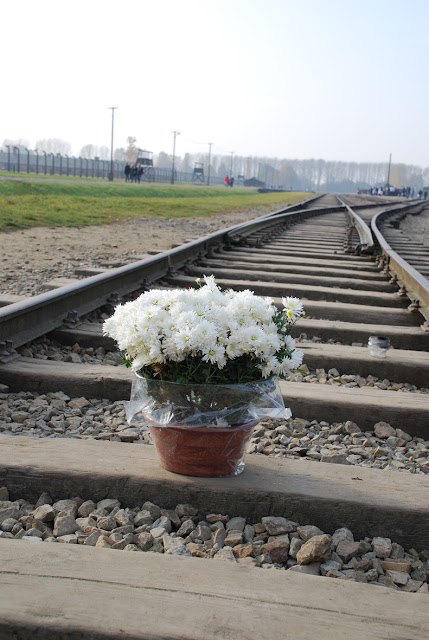Monday, 31st October, 2011. The day I remembered my Jewish heritage, the day I walked in the footsteps of my ancestors, possibly traced their final journeys. The day I visited the place that bore witness to atrocities that shook the world and changed the history of Judaism forever. The day I visited Auschwitz.
I had booked a tour with Krakow Shuttle and was picked up outside my hotel bang on time. The next 20 minutes was spent driving to other hotels to pick up more people and by 09:30 we were on the road. Some 80 minutes later we had reached the infamous Auschwitz I.
 |
| First look |
As we walked under the
Arbeit Macht Frei gate, my first (and rather inappropriate) thought was that it was quite pretty: all red brick buildings set off by yellow autumn leaves... But it was like glancing at something and not quite seeing the full picture. Once you saw the triple fence of barbed electrified wire, you knew that this was no ordinary housing complex. No, this was the first concentration camp in Poland, and later the mass grave of at least one million Jews. This was where 'Doctor' Josef Mengele conducted all his vile experiments in a bid to find a means of rapidly increasing the Aryan population through multiple births, and decreasing the 'unwanteds' through mass sterilisation. This was where death was the only freedom for inmates...
 |
| The dreaded gate |
 |
| Autumn colours at odds with the purpose of the camp |
 |
| I can't even begin to imagine the horror of being imprisoned here |
 |
| Stark and foreboding |
If Auschwitz I looks unfamiliar, it's probably because it is. Films and documentaries all show the much sparser, much deathlier Auschwitz II, aka Auschwitz-Birkenau. Thirty times bigger and home to most of the mass extermination, Birkenau was designed to house and kill more Jews, Roma and ethnic minorities than several of the other camps put together. Sickeningly there was even a train that took people directly to the five purpose-built gas chambers which, as the camp reached capacity and then some (at one point it had 40,000 inmates), became the first – and last – port of call for most late entrants. They never even stood a chance.
Back in Auschwitz I, we were shepherded into big rooms, rooms which used to house the inmates and which now house collections of things that belonged to them. When I saw the piles of human hair which had been hacked off, some of it still plaited, I felt sick. Seeing piles of carefully-labelled suitcases, which had been confiscated and plundered, was heart-breaking.
 |
| Block 14a, which once housed prisoners |
 |
| Block 10, where Mengele carried out his experiments on inmates |
In another room there were tins of shoe polish bearing inscriptions in a multitude of languages, Dutch, German, Greek, Russian, Polish, Italian, Hungarian, proof that the Nazis were shipping in Jews and other unwanteds from all over Europe. And in yet another room there was a collection of confiscated shoes – 40,000 pairs of them. And that was only a fraction of the total. The rest had been re-designated or transported to Berlin to give to the poorer Nazi families.
One of the worst parts though was seeing the photographs of emaciated, abused and broken people, and hearing that many of the survivors died just days after liberation. Can you imagine surviving a concentration camp (and a Polish winter or two) for months on end and then dying just days or even hours after you got out?!
 |
| Sign befitting a death camp |
Having seen Auschwitz I, we were driven the short distance to Auschwitz II. The 'familiarity' of this site shook me. Standing on the train tracks, the same tracks that had been the final destination for so many people, was unsettling.
 |
| The watch tower |
 |
| Flowers left on the train tracks |
 |
| The end of the line |
Our guide took us to see the inmates' former living quarters, little more than long, wooden sheds through which the wind must have whistled in the depths of the Polish winters. Rows of bunks in one, rows of concrete potties in another, nothing whatsoever in a third. If those walls could speak, what would they say?
 |
| The wooden sheds which formed the inmates' living quarters |
 |
| Rows of bunks |
 |
| The 'bathroom' |
 |
| An empty shed |
Back outside, we were given free reign to explore alone, left to our own devices and thoughts. I broke away from the group to simply stand and try and process the enormity of what I'd just witnessed, the realisation that thousands upon thousands of Jews, Roma and other ethnic people lived and died in those very sheds...
 |
| Looking down the tracks |
It felt somehow wrong to be a tourist at a death camp, wrong to even want to visit such a place. But if, as I suspect, that is where my relatives ended up and ended their days, I couldn't NOT go. I couldn't not visit their final resting place. Regardless of where they ended up, I couldn't not acknowledge the atrocities carried out there, couldn't not pay my respects to the millions who lost their lives for nothing.
 |
| Silence at last... |
It's been almost four years since I went there, but what I saw, what I felt, what I sensed, has stayed with me and will for the rest of my life...































































